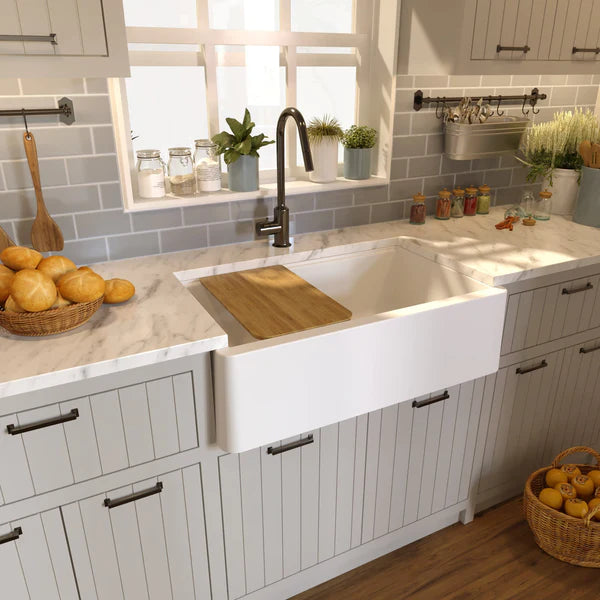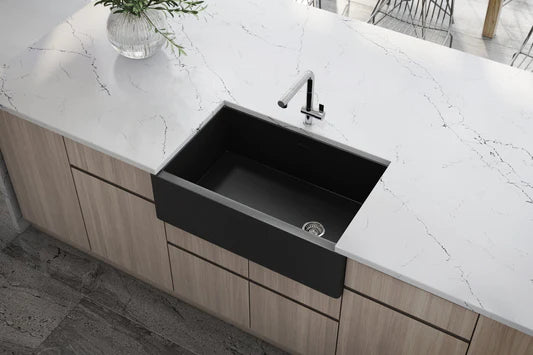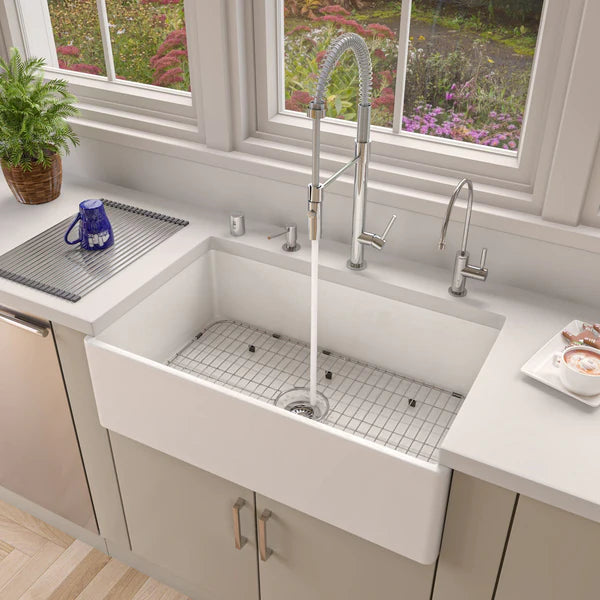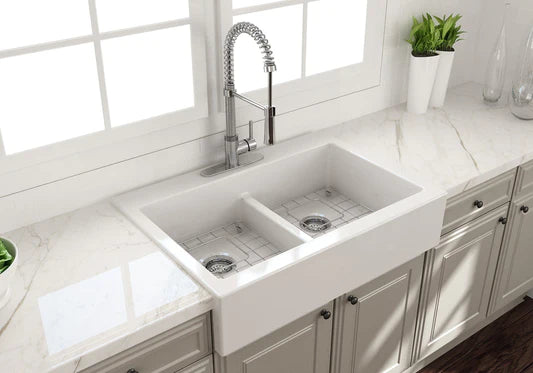The farmhouse sink, with its deep basin and distinctive apron front, has become a staple in both traditional and contemporary kitchen designs. This type of sink, known for its generous size and aesthetic appeal, serves as a focal point in the kitchen, blending functionality with style. As homeowners and designers alike gravitate towards adding a touch of rustic charm to modern kitchens, the choice of the right farmhouse sink size becomes paramount. The size not only affects the sink's practicality and efficiency in daily tasks but also influences the overall look and feel of the kitchen space.
Choosing the correct size for a farmhouse sink involves more than just measuring the available space on your countertop. It requires a thoughtful consideration of kitchen layout, cabinet size, and your lifestyle needs. Whether you are an avid cook who needs a large, single basin for handling big pots and pans, or you prefer a double basin to separate clean and dirty dishes, the right size can significantly enhance your kitchen's functionality. Moreover, the size of the sink will impact the installation process, potentially necessitating adjustments to existing cabinetry and plumbing.
This guide aims to navigate the myriad of options available, providing a detailed look into standard farmhouse sink sizes, factors influencing size selection, and tips for ensuring your chosen sink fits harmoniously within your kitchen's design. Understanding the standard sizes available and the considerations for choosing the right one will empower you to make an informed decision that marries the practical needs of your household with the aesthetic goals of your kitchen redesign.
Understanding Farmhouse Sinks
Originating in a time before running water, farmhouse sinks were designed to hold a large volume of water, catering to the needs of farmhouses where a significant amount of food preparation and cleaning was done. This historical context explains their generous size and deep basins, features that are still appreciated in modern kitchens for their functionality and style.
The distinguishing feature of a farmhouse sink is its front-facing apron, which protrudes slightly beyond the edge of the cabinetry. This design not only adds a visually appealing element to the kitchen but also contributes to the sink's functionality by reducing the strain on the user's back, making it easier to reach into the basin without leaning over a countertop. It's a marriage of form and function that harkens back to simpler times while fitting seamlessly into contemporary kitchen designs.
Farmhouse sinks are available in a variety of materials, each offering its unique benefits and aesthetic appeal. Stainless steel is a popular choice for its durability, resistance to heat, and ease of cleaning, making it a practical option for busy kitchens. Fireclay, another favored material, offers a classic look with its glossy finish and resistance to scratches and stains. Copper sinks, while requiring a bit more maintenance to preserve their finish, provide a living surface that evolves with time, adding a unique character to the kitchen. Additionally, cast iron coated with enamel combines the vintage appeal of early farmhouse sinks with the benefits of modern materials, including a vast array of colors to match any decor.
Choosing the right material is crucial as it influences the overall look and feel of the kitchen, as well as the sink's maintenance needs and durability. It also plays a role in determining the appropriate size of the sink, as some materials may be more suitable for larger single basin designs, while others lend themselves to smaller, double basin configurations.
Understanding the origins, distinctive features, and material options of farmhouse sinks is essential for anyone considering this style for their kitchen. This knowledge ensures a choice that not only meets practical needs but also complements the kitchen's design, making the farmhouse sink a focal point that blends history with modern utility.
Standard Sizes of Farmhouse Sinks

When integrating a farmhouse sink into your kitchen, understanding the standard sizes available is crucial for ensuring a fit that complements your space and lifestyle. Typically, farmhouse sinks range in length from 20 to 36 inches, with the most common sizes being 30 inches for smaller kitchens and 33 or 36 inches for standard to larger kitchens. The width (front to back) usually varies from 18 to 22 inches, accommodating different counter depths and usage needs. Depth, an essential aspect for functionality, ranges between 8 and 10 inches, providing ample space for washing large pots and pans or handling significant amounts of dishes.
Single bowl farmhouse sinks offer a wide, uninterrupted space for kitchen tasks, making them ideal for soaking large items. These sinks typically range in size from 24 to 36 inches in length, providing versatility for different kitchen sizes. On the other hand, double bowl sinks, which are divided into two compartments, can range from 30 to 36 inches in length. These sinks offer the convenience of separating washing and rinsing areas but may require a larger kitchen layout to accommodate their size comfortably.
Choosing between a single or double bowl farmhouse sink depends on your cooking and cleaning habits. If you frequently cook large meals or use oversized pots and pans, a larger single basin might be more practical. Conversely, if you prefer having separate areas for different tasks, a double basin sink could better suit your needs, provided you have the space to accommodate it.
It's also important to consider the impact of sink size on installation and cabinetry. Larger sinks might require custom cabinetry and potentially more extensive renovations to fit seamlessly into your kitchen design. Therefore, measuring your available space and consulting with a professional can ensure that your chosen farmhouse sink size enhances your kitchen's functionality and aesthetic appeal, fitting perfectly into your daily life and kitchen activities.
Factors Influencing Size Selection

Selecting the appropriate size for your farmhouse sink is influenced by several key factors that extend beyond mere aesthetics. Understanding these considerations can help you choose a sink that not only fits your kitchen’s design but also supports your lifestyle and usage habits.
Kitchen and Counter Space
The size of your kitchen and the available counter space play a pivotal role in determining the ideal size for your farmhouse sink. In smaller kitchens, a large sink can overwhelm the space and limit counter area for food preparation. Conversely, in a spacious kitchen, a small sink may appear disproportionate to the room’s scale. Aim for a balance that enhances functionality without compromising on style.
Cabinet Size Compatibility
Before selecting a farmhouse sink, it’s crucial to consider the size of the existing cabinetry where the sink will be installed. Farmhouse sinks require a supportive cabinet that is wide enough to accommodate the sink’s base while leaving enough room for the sink's apron front. This might necessitate modifying existing cabinets or planning for appropriate cabinetry in a new kitchen layout.
Usage Patterns
Your daily kitchen activities and habits should influence the size of the farmhouse sink you choose. If you cook frequently or entertain often, requiring space for large pots and pans, a larger single basin sink may be more practical. For those who prefer multitasking or separating wash and rinse areas, a double basin sink might be more suitable, provided your kitchen layout can accommodate it.
Impact on Kitchen Workflow and Ergonomics
The size of your farmhouse sink can significantly affect the kitchen workflow and ergonomics. A sink that is too large may lead to unnecessary reaching and bending, causing discomfort over time. Similarly, a sink that is too small may not meet your needs, leading to a cluttered and inefficient workspace. Consider how the sink size will integrate into your kitchen’s workflow, ensuring that it complements the way you move and work within the space.
By carefully considering these factors—kitchen size, cabinet compatibility, usage patterns, and the impact on workflow and ergonomics—you can select a farmhouse sink size that not only looks great but also enhances the functionality and comfort of your kitchen environment.
Customization Options for Farmhouse Sink Sizes

While standard sizes of farmhouse sinks cater to a broad range of needs, there may be instances where customization becomes necessary to perfectly match your kitchen's specific requirements. Custom farmhouse sinks offer the flexibility to tailor dimensions, materials, and finishes to your exact preferences, ensuring a perfect fit and a unique look.
Opting for a custom size allows you to overcome potential challenges posed by unusual kitchen layouts, non-standard cabinetry, or specific design visions that standard sinks cannot accommodate. For example, if your kitchen features an exceptionally wide or narrow counter space, a custom-sized sink can be crafted to utilize the area efficiently without sacrificing functionality or aesthetics.
However, it's important to weigh the benefits against the drawbacks. Custom sinks typically come with a higher price tag due to the additional labor and materials required to meet your specifications. Additionally, the lead time for a custom sink can be significantly longer than purchasing a standard size off the shelf. This might extend your kitchen renovation timeline and require more upfront planning.
Before deciding on a custom farmhouse sink, consider the implications for your budget and project schedule. It's also advisable to consult with a professional supplier such as Manor House Sinks. We can provide valuable insights into whether a custom solution is necessary or if adjustments to cabinetry and plumbing might allow for the use of a standard sink size, potentially saving time and money.
Ultimately, the decision to go custom should be based on a careful assessment of your kitchen's unique needs, balanced against the costs and timeline implications. Custom farmhouse sinks can provide a perfect fit and personalized touch, making them a worthwhile investment for many homeowners.
Installation Considerations

The installation of a farmhouse sink is a critical step that demands careful consideration to ensure both functionality and aesthetic harmony in your kitchen. Unlike standard drop-in or undermount sinks, farmhouse sinks often require more involved preparation and installation due to their size, weight, and unique front-apron design.
It's essential to verify that your cabinetry can accommodate the weight and dimensions of a farmhouse sink. This might involve reinforcing the cabinet structure or modifying the cabinet face to fit the apron front. Additionally, a common misconception is that a 36" sink can fit into a 36" base cabinet; however, the cabinet width must be at least 3 inches more than the width of the sink to ensure a proper fit and adequate space for installation adjustments. For instance, a 36-inch sink should be matched with a minimum of a 39-inch cabinet base.
Furthermore, because farmhouse sinks sit slightly forward in the cabinetry, adjustments to the countertop and existing plumbing may be necessary. Precise measurements and cuts need to be made in the countertop material to align with the sink's dimensions, requiring skilled craftsmanship to achieve a polished look.
Professional installation is highly recommended for farmhouse sinks, as the process involves intricate adjustments that can impact the sink's functionality and durability. An experienced installer will ensure proper alignment, prevent leaks, and address any unforeseen challenges that may arise during the installation process.
Moreover, consider the sink's placement in relation to other kitchen elements. The position of the farmhouse sink should facilitate an efficient workflow, providing easy access to the stove, refrigerator, and preparation areas. This strategic placement enhances the kitchen's functionality, making daily tasks more manageable and enjoyable.
Successful installation of a farmhouse sink requires meticulous planning, professional expertise, and consideration of its integration into the kitchen's overall layout. These steps are crucial in maximizing the benefits of your farmhouse sink, ensuring it becomes a cherished and functional feature of your kitchen.
Maintenance and Care

Maintaining the beauty and functionality of your farmhouse sink requires understanding the specific care practices suited to its material and size. Regardless of the sink's dimensions, regular maintenance is key to ensuring its longevity and preserving its aesthetic appeal.
For stainless steel farmhouse sinks, routine cleaning with mild soap and water, followed by drying to prevent water spots, is often sufficient. However, to tackle tougher stains or scratches, specialized stainless steel cleaners and non-abrasive sponges are recommended. The size of the sink may dictate the effort required for cleaning, with larger sinks potentially needing more time to clean thoroughly.
Fireclay and cast iron sinks, known for their durability and resistance to staining, still require careful handling to avoid chips or cracks. Using gentle cleaners without harsh chemicals and avoiding abrasive scrubbing pads will keep these surfaces looking new. Additionally, immediate cleanup of spills, especially acidic substances, can prevent damage to the enamel or glazed surface.
Copper farmhouse sinks offer a unique aspect as they develop a patina over time. To maintain their natural beauty, regular rinsing and gentle drying are advisable. Avoid harsh cleaners that can strip the patina, and consider applying a copper wax periodically to protect the surface.
Regardless of material, avoiding the use of harsh chemicals and sharp objects that can damage the sink is a universal guideline. With regular care and the right cleaning techniques, your farmhouse sink can remain a functional and beautiful centerpiece in your kitchen for years to come.
Conclusion: Farmhouse Sink Sizes
Choosing the right farmhouse sink size is more than a matter of personal taste; it's a decision that impacts the functionality, aesthetics, and overall workflow of your kitchen. As we've explored, from understanding the basics of farmhouse sinks, navigating standard sizes, to considering installation and maintenance, each aspect plays a critical role in ensuring that your kitchen not only looks great but also works efficiently for your needs.
The process of selecting a farmhouse sink requires careful consideration of your kitchen's size, the compatibility with existing cabinetry, and how the sink's size will influence daily tasks and overall kitchen ergonomics. Whether you opt for a standard size or venture into custom dimensions, the goal is to enhance your kitchen's functionality while adding a timeless aesthetic appeal.
The installation of a farmhouse sink is also a crucial step that can significantly influence its performance and longevity. Professional installation ensures that your sink is correctly positioned and securely fitted, preventing future problems and ensuring ease of use. Additionally, understanding the maintenance requirements of your chosen sink material will help you keep your sink looking pristine and functioning well over time.
The journey to finding the perfect farmhouse sink size for your kitchen is a blend of practical considerations and personal style. By taking into account the factors discussed, you're well-equipped to make an informed decision that balances functionality with the unique charm that farmhouse sinks bring to any kitchen design. Remember, the right farmhouse sink can transform your kitchen into a welcoming, efficient space that you and your family will enjoy for years to come.
Discover the perfect blend of style and functionality for your kitchen with our exquisite collection of farmhouse sink sizes.
Further reading
For additional information on the installation and care of farmhouse sinks, here are some resources that provide detailed guidance and support:
- Bocchi's Installation and Care Guide: Dive into Bocchi's expert advice on installing and maintaining their farmhouse sinks to ensure they remain a beautiful and durable part of your kitchen for years to come. Bocchi offers detailed guides tailored to their unique sink models, covering everything from initial installation to routine maintenance. Check out their resources to gain a deeper understanding of how to care for your sink and ensure its longevity and optimal performance.


